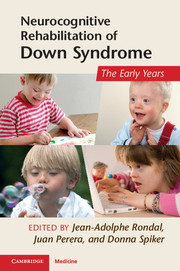Book contents
- Frontmatter
- Contents
- List of contributors
- Preface
- Acknowledgments
- Section 1 Definition, history, methodology, and assessment
- Section 2 Genetics, brain, and animal models
- Section 3 Pharmacological and medical management and treatment
- 7 Pharmacotherapy for children with Down syndrome
- 8 Early medical caretaking and follow-up
- 9 Evaluation and management of cardiovascular diseases in Down syndrome
- Section 4 Early development and intervention
- Section 5 Therapeutic perspectives
- Conclusions
- Index
- References
9 - Evaluation and management of cardiovascular diseases in Down syndrome
Published online by Cambridge University Press: 05 July 2011
- Frontmatter
- Contents
- List of contributors
- Preface
- Acknowledgments
- Section 1 Definition, history, methodology, and assessment
- Section 2 Genetics, brain, and animal models
- Section 3 Pharmacological and medical management and treatment
- 7 Pharmacotherapy for children with Down syndrome
- 8 Early medical caretaking and follow-up
- 9 Evaluation and management of cardiovascular diseases in Down syndrome
- Section 4 Early development and intervention
- Section 5 Therapeutic perspectives
- Conclusions
- Index
- References
Summary
Introduction
Down syndrome (DS) is the most common chromosomal anomaly. Its overall worldwide prevalence is approximately 10 per 10,000 live births, a number which tended to increase over the recent years. The increasing average maternal age at childbirth mostly explains the elevated prevalence of the syndrome. In the Netherlands, the prevalence of DS was estimated to be 16 per 10,000 live births in 2003 (Weijerman et al., 2008). Similarly, DS accounts for up to 8% of all registered cases of congenital anomalies in Europe (De Walle & Cornel, 1995).
Historically, the association between DS and congenital heart disease (CHD) was described very early on. Down, in his original description of 1866, mentioned the possibility of cardiac disease and reported that “the circulation is feeble.”
In 1894, Garrod reported the association between DS and CHD. In the early twentieth century, the presence of CHD was used as a feature to distinguish DS from cretinism. The specific association between DS and atrioventricular septal defect (AVSD) was reported by Ablert in 1924 and more accurately by Helen Taussig in 1947. The incidence of CHD in DS was first described with very wide variations, from 16% to 62% (Berg et al., 1960). The current observations demonstrate that infants with DS have a 40%–50% risk of CHD (Wells et al., 1994; Marino, 1996; Stoll et al., 1998; Freeman et al., 2008; Weijerman et al., 2008).
- Type
- Chapter
- Information
- Neurocognitive Rehabilitation of Down SyndromeEarly Years, pp. 128 - 141Publisher: Cambridge University PressPrint publication year: 2011



